An Efficient New Technique for Solving Nonlinear Problems Involving the Conformable Fractional Derivatives
Abstract
In this paper, an efficient new technique is used for solving nonlinear fractional problems that satisfy specific criteria. This technique is referred to as the double conformable fractional Laplace-Elzaki decomposition method (DCFLEDM). This approach combines the double Laplace-Elzaki transform method with the Adomian decomposition method. The fundamental concepts and findings of the recently suggested transformation are presented. For the purpose of assessing the accuracy of our approach, we provide three examples and introduce the series solutions of these equations using DCLEDM. The results show that the proposed strategy is a very effective, reliable, and efficient approach for addressing nonlinear fractional problems using the conformable derivative.
1. Introduction
Recent studies have shown that fractional calculus (FC) is needed to model many real-life situations in engineering and sciences. It has been widely employed in mathematics, mechanics, chemical engineering, and other scientific and technical disciplines [1–3]. According to recent research studies, fractional calculus can more effectively reflect some nonlinear effects. Fractional derivatives have been defined in a number of ways in the literature, like Caputo, Hadamard, Riesz, Weyl, Atangana-Baleanu-Caputo, Caputo-Fabrizio, conformable derivatives, M-truncated derivatives, and beta derivatives [4–9]. Most of these definitions referred to above lack some basic properties for the case of integer order, such as the property that not all of them follow the chain rule, the product rule, and the quotient rule of two functions, and the conformable derivative among them still fulfills the classical properties of integer derivatives. So, it is simple to use to solve linear and nonlinear fractional differential equations (NFDEs). Khalil et al. [4] developed the conformable derivative (CD), a more recent development of the conventional limit definition for the derivative of a function. This new derivative has been used with other methods [10–13] in a lot of different situations because it is so simple to use. Hashemi [10] established the invariant subspace approach for obtaining accurate solutions to a variety of conformable time fractional differential equations. Osman et al. [11] came up with a new way to solve singular fractional pseudohyperbolic and pseudoparabolic equations using a modified double conformable Laplace transform. A lot of NPDEs with conformable derivatives were solved using the conformable double Laplace-Sumudu iterative approach [12]. Bhanotar and Kaabar [13] came up with the conformable triple Laplace transform decomposition technique to solve NFPDEs analytically.
Various methods for transforming new double integrals have been successfully developed in recent years [14–17], where definitions and results have been provided and many different types of differential equations have been solved. Al-Sook and Amer [14] utilized the Laplace-Elzaki transform to solve the integral and partial differential equations. Elzaki and Iashag [15] obtained the solution of the telegraph equation by the Elzaki-Laplace transform. Ahmed et al. [16, 17] created the Laplace-Sumudu transform to solve a variety of fractional and partial differential equations.
George Adomian introduced the Adomian decomposition method (ADM) [18–23] in 1980, which is an effective approach for finding numerical and exact solutions to a broad class of differential equations that are either linear or nonlinear. This approach has the benefit of generating results quickly since it gives analytic series solutions to the target equations without the need for any constrained assumptions, transformations, or discretization. The double transformation techniques have some advantages over other strategies in that they have faster convergence to the solution. Regrettably, this transformation, like other transformations, lacks the ability to handle nonlinear situations. So, in this work, we have proposed a novel strategy that combines the double conformable Laplace-Elzaki transform with the decomposition method (DM) called the double conformable Laplace-Elzaki decomposition method (DCLEDM). The DCLEDM approach allows speedy convergence of the precise solution without making any restrictive assumptions about the answer. This is one advantage of employing the decomposition method in conjunction with the DCLET approach.
The following components comprise the study’s overall construction: Section 2 contains some essential definitions and theorems for conformable fractional derivatives (CFDs). Section 3 presents fundamental DCLET definitions, features, and theorems. Section 4 talks about the model and steps for using the DCLET and decomposition methods to solve the NCFPDEs that were mentioned analytically. Three hypothetical scenarios are given in Section 5 to illustrate the recommended approach’s liability, convergence, and efficacy. The statistical findings are given in Section 6. Section 7 includes conclusions.
2. Conformable Fractional Derivative (CFD)
To achieve our significant results, we now define the CFD and its fundamental qualities, which are described below.
Definition 1 (see [4].)Given that a function ψ : (0, ∞)⟶R is a real-valued function, then the CFD of ψ order ϑ2 ∈ (0, 1] is defined by
Definition 2 (see [24].)Given that a function ψ(u, v): R × (0, ∞)⟶R, the conformable space and time fractional partial derivative for the function ψ(u, v) of orders ϑ1 and ϑ2, respectively, is given as follows:
Proposition 3. Suppose 0 < ϑ1, ϑ2 ≤ 1, c, d, λ, and μ ∈ ℝ; then
3. Double Conformable Laplace-Elzaki Transform (DCLET)
In this part, we present the DCLET and some of its features that can be used to solve some NCFPDEs in the future. The reader can get more details about the proposed transformation in [14, 15].
Definition 4. Let ψ(u, v) be a function of two variables u, v ∈ ℝ+.
- (i)
The CLT of ψ(u, v) with respect to u of exponential of order ϑ1 is denoted by and defined as
The CET of ψ(u, v) with respect to v of exponential of order ϑ2 is denoted by and defined as
- (ii)
The DCLET of function ψ(u, v) of exponential of orders ϑ1 and ϑ2 is denoted by and defined as
It is worth mentioning that if ψ(u, v) meets the essential requirements [25], then
The inverse double conformable Laplace-Elzaki transform (IDCLET) is defined by
Theorem 5 (see [26].)Assume ψ : ℝ × (0, ∞)⟶ℝ such that exists, then
Proof. Here, we provide evidence for results (1) and (3).
(1)
(3)
The same procedure may be used to illustrate the remaining outcomes.
Theorem 8. Assume and ; then,
- (i)
- (ii)
- (iii)
- (iv)
Proof.
- (i)
It is simple to verify (i) by using the definition of the CDSET
- (ii)
Put s = (q/(1 + c2q)); then,
- (iii)
Suppose γ = λw and η = μv; then,
Theorem 9 (see [14].)Suppose that ψ(u, v) is a function of exponential order a and b defined on the intervals (0, U) and (0, V); then, DLET of ψ(u, v) is well defined for all w and 1/q supplied Re[w] > a and Re[1/q] > b.
Theorem 10 (see [29].)If , then the DCLET of the FPDs and can be represented as follows: 0 < ϑ1, ϑ2 ≤ 1
The findings described above may be broadly expanded as follows:
Theorem 11 (convolution theorem). Assume that ψ(u, v) and ξ(u, v) are two functions of the CDSET; then,
The CDLET for certain essential functions is summarized in Table 1.
4. Descriptions of the Method
4.1. Convergence of the Proposed Method
The method suggests that the solution is expressed in the form of an infinite series. Therefore, the concerned series rapidly converges to the solution. For more information about the convergence of the proposed method, you can refer to [30–33].
5. Numerical Applications
In this part, DCLEDM is applied to the following classes of NFPDs of the conformable derivative type to demonstrate the capability and effectiveness of DCLEDM.
Example 1. Consider the following NCFPD:
Solution: operating the DCLET on both sides of Eq. (34), we get
Applying the CLT for the IC (35) and the CET for the BC (36), one can obtain
Substituting Eq. (38) into Eq. (37) yields the simplified
By applying the on both sides of Eq. (39), we have
Now, by DCLEDM
The nonlinear term can be defined as
With
We put the equations ((41) and (42)) into Eq. (40), and then, we get
Also, we can obtain the other components in the following form:
Thus, if we substitute Eq. (45) into Eq. (47), we get
Hence, we obtain the following series solution to Eq. (34):
In the following example, we will discuss the solution of the KdV equation, which has many physical applications, including an approximate description of long water waves, acoustic wave propagation in plasma, long internal waves in density, and shallow water waves.
Example 2. Consider the fourth order KdV problem of NCFPD:
Solution: by implementing the DCLET for both sides of Eq. (51), the CLT for Eq. (52), and the CET for Eq. (53), we get
or
According to equations ((31)–(33)), the first three terms are derived as follows:
Consequently, we derive the subsequent series solution for Eq. (51):
Example 3. Consider the following NCFPD:
Solution: by applying the DCLET to both sides of Eq. (59) and the CLT to Eq. (60), we get
By applying the on both sides of Eq. (61), we have
The DCLEDM proposes an infinite series solution for the function in infinite series:
We put the equations ((63) and (64)) into Eq. (62); then, we get
As a result, the zeroth component from Eq. (59) is as follows:
Thus, substituting Eqs. (67) and (68) into Eq. (70), we get
Hence, we obtain the following series solution to Eq. (59).
6. Results and Discussion
This part evaluates the precision and efficacy of the suggested method by comparing the approximate and exact results using graphical representations and tables. Figures 1-3 display the 3D plot of approximate solutions found using the current approach. These solutions are compared with the exact solutions for ϑ1 = ϑ2 = 1 in Examples 1–3. These figures show how well the precise answers and the DCLEDM approximations match up. These pictures (Figures 4-6) show lines that show how the proposed method’s approximation solutions compare to the exact answers from Examples 1–3. These comparisons are conducted for different values of the variable v as well as the fractional-order variables ϑ1 and ϑ2. The line plots of the estimated series solution using DCLEDM actually match those of the exact solution, as seen in the figures. Moreover, the solution obtained using the current method converges to the exact answer with greater accuracy as the order of approximation increases and the fractional values ϑ1 and ϑ2 approach one. Tables 2–4 compare the exact and approximate solutions for each example in relation to the absolute error at u = 1, ϑ1 = ϑ2 = 0.8,0.9, and 1 for various values of the variable v. Based on the data shown in the figures and tables, our solution technique demonstrates rapid convergence towards an accurate solution.
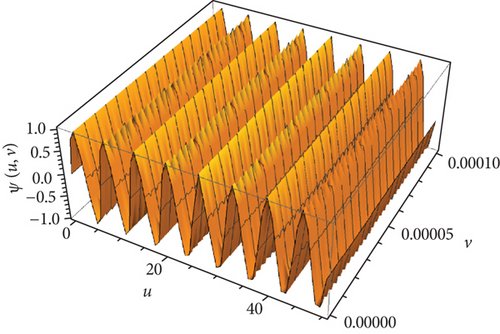

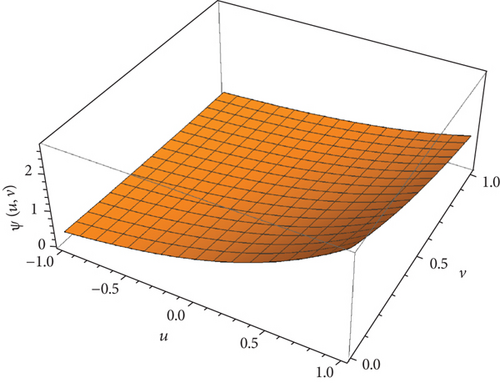
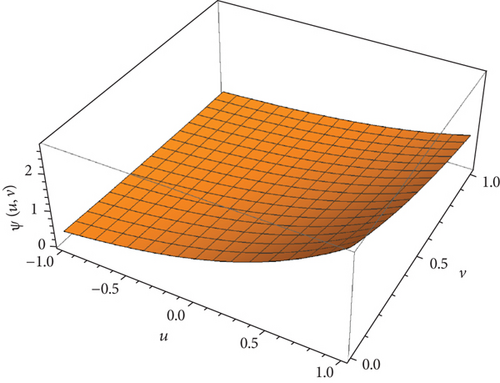
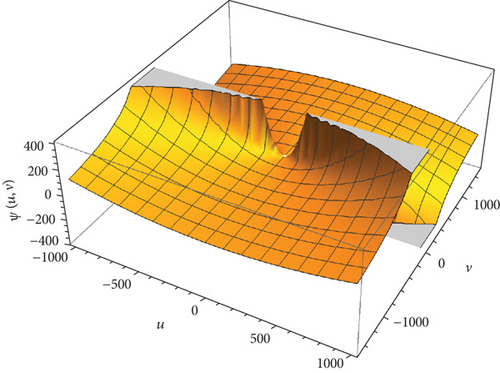
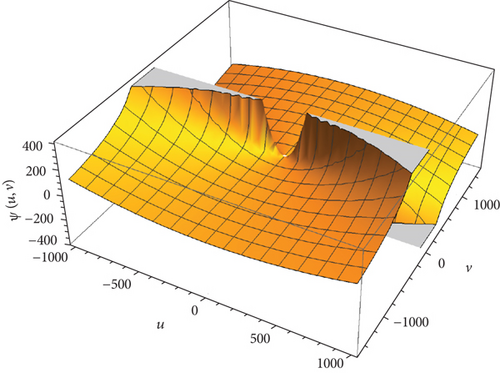
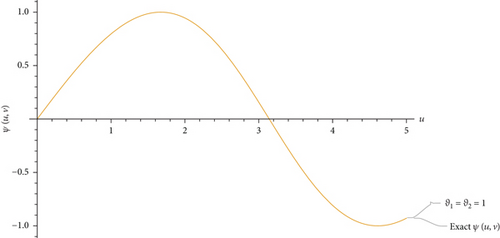
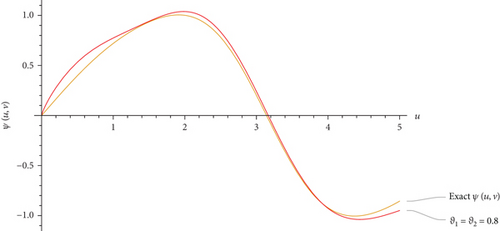

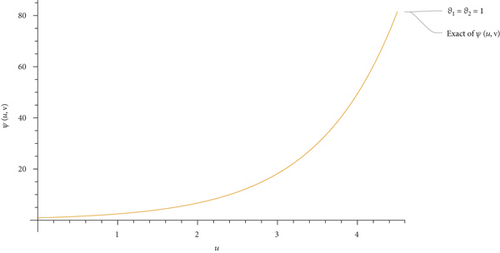
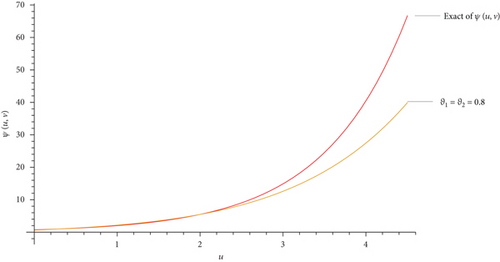
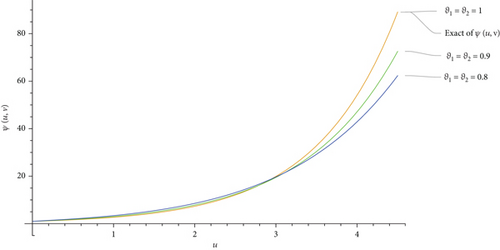
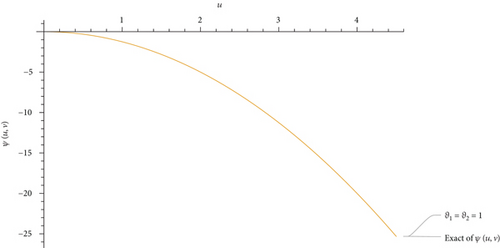
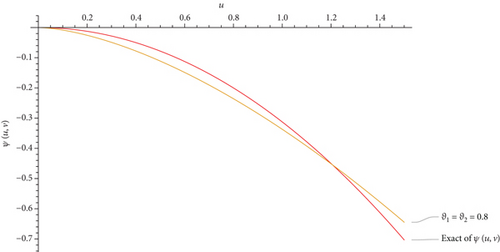
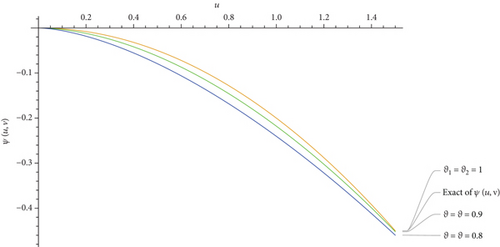
| u | v | ϑ1 | ϑ2 | CDLEDM ϑ1 = ϑ2 = 0.8,0.9 |
Exact ϑ1 = ϑ2 = 1 |
|ψExact − ψCDLEDM| ϑ1 = ϑ2 = 0.8,0.9 |
|---|---|---|---|---|---|---|
| 1 | 0.01 | 0.8 | 0.8 | 0.939317 | 0.836932 | 1.02385 × 10−1 |
| 0.02 | 0.931822 | 0.832409 | 9.94127 × 10−2 | |||
| 0.03 | 0.924856 | 0.827904 | 9.69516 × 10−2 | |||
| 1 | 0.01 | 0.9 | 0.9 | 0.889163 | 0.836932 | 5.22308 × 10−2 |
| 0.02 | 0.883036 | 0.832409 | 5.06267 × 10−2 | |||
| 0.03 | 0.877195 | 0.827904 | 4.92913 × 10−2 | |||
| u | v | ϑ1 | ϑ2 | CDLEDM ϑ1 = ϑ2 = 0.8,0.9 |
Exact ϑ1 = ϑ2 = 1 |
|ψExact − ψCDLEDM| ϑ1 = ϑ2 = 0.8,0.9 |
|---|---|---|---|---|---|---|
| 1 | 0.01 | 0.8 | 0.8 | 3.38245 | 2.69123 | 6.91219 × 10−1 |
| 0.02 | 3.30465 | 2.66446 | 6.40198 × 10−1 | |||
| 0.03 | 3.23615 | 2.63794 | 5.98208 × 10−1 | |||
| 1 | 0.01 | 0.9 | 0.9 | 2.98471 | 2.69123 | 2.93471 × 10−1 |
| 0.02 | 2.93953 | 2.66446 | 2.75074 × 10−1 | |||
| 0.03 | 2.8973 | 2.63794 | 2.59351 × 10−1 | |||
| u | v | ϑ1 | ϑ2 | CDLEDM ϑ1 = ϑ2 = 0.8,0.9 |
Exact ϑ1 = ϑ2 = 1 |
|ψExact − ψCDLEDM| ϑ1 = ϑ2 = 0.8,0.9 |
|---|---|---|---|---|---|---|
| 1 | 0.01 | 0.8 | 0.8 | 1.92519 | 1.06383 | 8.61359 × 10−1 |
| 0.02 | 2.32518 | 1.13636 | 1.18882 | |||
| 0.03 | 2.86009 | 1.21951 | 1.64058 | |||
| 1 | 0.01 | 0.9 | 0.9 | 1.38042 | 1.06383 | 3.16593 × 10−1 |
| 0.02 | 1.53777 | 1.13636 | 4.01402 × 10−1 | |||
| 0.03 | 1.72426 | 1.21951 | 5.04744 × 10−1 | |||
7. Conclusion
In this paper, the DCLEDM is introduced, along with a verification of its key features. Selected NCFPDEs are then solved using the DCLEDM. Additionally, graphical representations and tables are provided for the results of applying the DCLEDM, along with examples for various values of ϑ1 and ϑ2. We can conclude that this method can be a highly effective tool for solving a variety of fractional PDEs with conformable derivatives that arise in the fields of physics, chemistry, and engineering. In the future, the author also wants to look into resolutions for NCFPDEs by using DCLEDM and other noninteger fractional derivatives and then comparing the results with other methods to demonstrate the effectiveness of the method.
Conflicts of Interest
The authors declare that there are no conflicts of interest.
Open Research
Data Availability
The findings of this study are readily available from the author upon request for supporting data. Please contact the author with any data requests.




